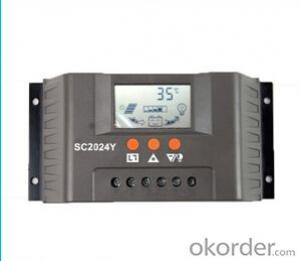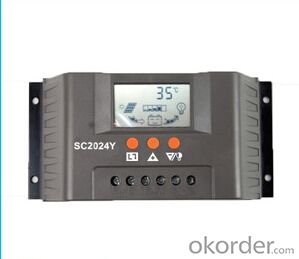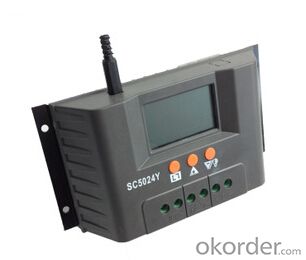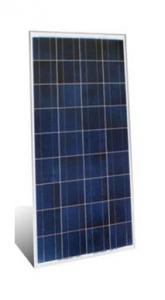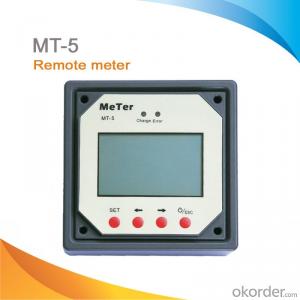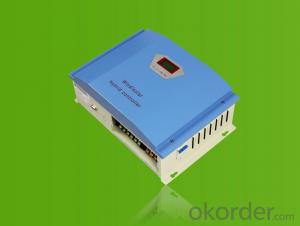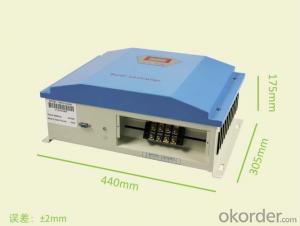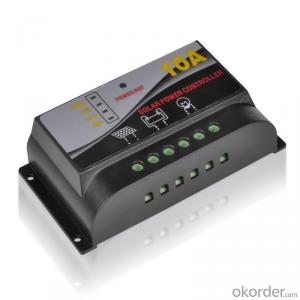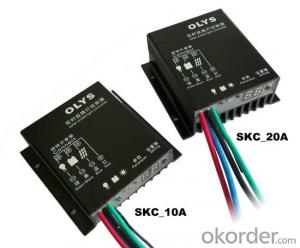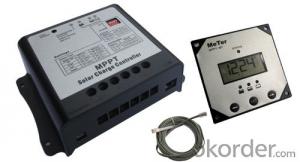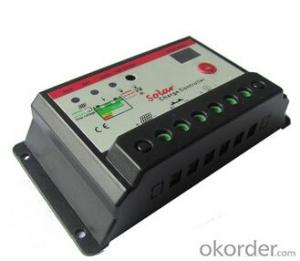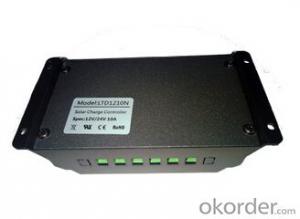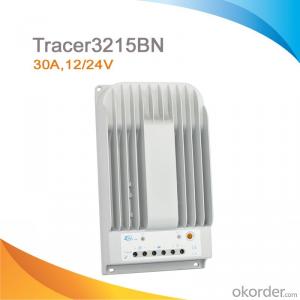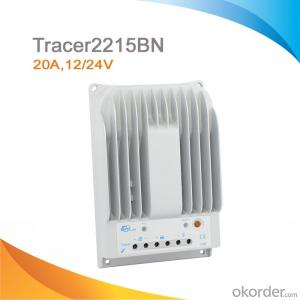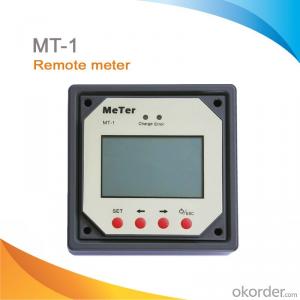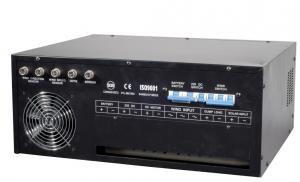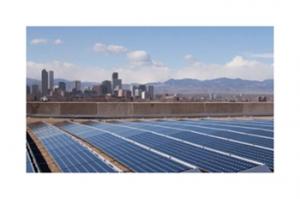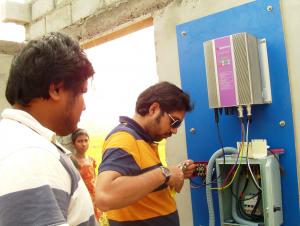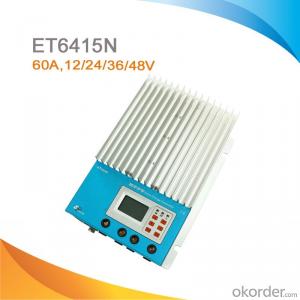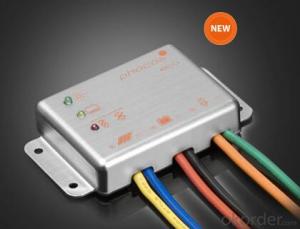12 Volt Solar Charge Controllers bygd intelligent solar controller model sc2024y
- Loading Port:
- Shanghai
- Payment Terms:
- TT OR LC
- Min Order Qty:
- 5 unit
- Supply Capability:
- 50 unit/month
OKorder Service Pledge
OKorder Financial Service
You Might Also Like
Specifications
Main characteristic: 20A PWM 12/24v solar panel charger,solar charge controller with LED
Specification:
Rated Voltage :12V/24V
Rated Load Current :<40a
Over Charge Current :13.7V
Over Discharge Current :10.5-11V
Light control: yes
Temperature control: yes
Time control: yes
Our solar controllers are designed for solar home system, ideal for rural electrification systems,and many advantages compared to other controllers:
Low Cost---
Solar controller has specifically designed to meet the needs of the rural electrification market. The low cost resulted from using the latest electronic technology and high volume manufacturing.
High Reliability--
We are manufacturer of solar charge controllers,power inverters,and solar power systems. All our products are designed for high quality and high reliability. The controller has a low failure rate and will last a long time, and got very good feedback from customers until now.
Electronic protections--
The solar controllers are built-in electronic fused that do not require replacements.
Tropicalization--
The solar controlers electronics are protected with moisture-tight coating, minimizing damage from humidity and from nesting insects.
Easy to use--
Solar controller is fully automatic and requires no adjustments or user selections.
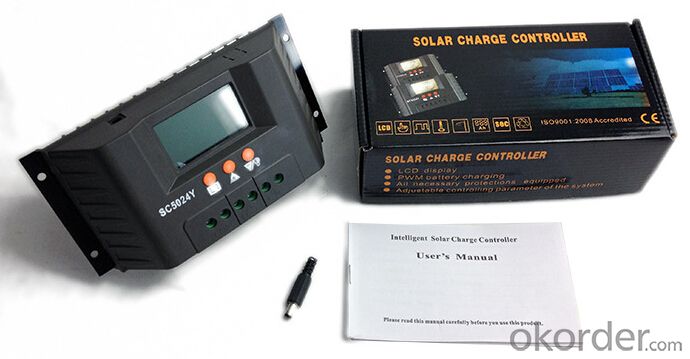
- Q: How do I choose the right solar controller for my solar system?
- Choosing the right solar controller for your solar system is an important decision that can significantly impact the efficiency and longevity of your system. Here are some steps to consider when selecting the appropriate solar controller: 1. Determine your system's voltage and current requirements: Start by understanding the voltage and current ratings of your solar panels and batteries. This information will help you choose a controller that can handle the specific requirements of your system. 2. Decide on the type of solar controller: There are generally two types of solar controllers - PWM (Pulse Width Modulation) and MPPT (Maximum Power Point Tracking). PWM controllers are simpler, more affordable, and suitable for smaller systems. MPPT controllers, on the other hand, are more advanced and efficient, making them ideal for larger systems or those with shaded or irregularly shaped panels. 3. Assess the maximum current and voltage rating: Ensure that the solar controller you choose can handle the maximum current and voltage produced by your solar panels. It is essential to select a controller that matches or exceeds the specifications of your system to avoid any potential damage or inefficiencies. 4. Consider additional features: Some solar controllers offer additional features such as temperature compensation, LCD displays, remote monitoring capabilities, and programmable settings. Evaluate these features based on your specific needs and preferences. 5. Read product reviews and recommendations: Look for customer reviews and recommendations from reputable sources or solar experts. This will help you gather insights and experiences from others who have used the particular solar controller you are considering. 6. Consult with a professional: If you are unsure or need expert advice, it is recommended to consult with a solar professional or installer. They can assess your system's requirements and provide guidance on selecting the right solar controller for your needs. Selecting the appropriate solar controller is crucial to ensure the optimal performance and longevity of your solar system. By considering factors such as voltage and current requirements, type of controller, maximum current and voltage rating, additional features, and seeking professional advice, you can make an informed decision and choose the right solar controller for your solar system.
- Q: Can a solar controller be used with solar-powered indoor religious institutions?
- Solar-powered indoor religious institutions can benefit from the use of a solar controller. This crucial component of a solar power system regulates the electricity flow from the solar panels to the batteries, ensuring efficient energy management and preventing overcharging. Although indoor religious institutions may not have direct access to sunlight, they can still harness solar power by installing solar panels on rooftops or nearby outdoor areas. The solar controller plays a vital role in managing the electricity generated by the solar panels and storing it in batteries. This stored energy can then power the indoor facilities, allowing religious institutions to reduce their reliance on conventional electricity sources and contribute to a more sustainable and environmentally-friendly energy alternative.
- Q: What is the maximum voltage that a solar controller can handle?
- The maximum voltage that a solar controller can handle varies depending on the specific model and brand. However, in general, most solar controllers can handle voltages up to 150 volts DC.
- Q: How do I determine the maximum load output voltage for a solar controller?
- To determine the maximum load output voltage for a solar controller, one must take into account several factors. Firstly, consulting the controller's specifications is essential. This can be done by referring to the user manual or product specifications provided by the manufacturer. Typically, these documents mention the maximum load output voltage under terms such as "maximum load voltage." Additionally, it is important to consider the voltage of the solar panel. Since the solar controller regulates the voltage from the panel to the load, the maximum load output voltage should be lower than the maximum voltage that the solar panel can generate. Therefore, it is crucial to ensure compatibility between the controller's maximum load output voltage and the solar panel's specifications. Moreover, it is necessary to take into account the voltage requirements of the devices or appliances that will be connected to the solar controller. It is important to ensure that the maximum load output voltage of the controller is suitable for powering these devices. If the load voltage requirements are lower than the controller's maximum load output voltage, there should not be any issues. Lastly, one must consider safety precautions. It is crucial to note that exceeding the maximum load output voltage can potentially cause damage to the connected devices or appliances. Therefore, it is of utmost importance to ensure that the load voltage requirements fall within the specified range of the solar controller. By considering the controller's specifications, the solar panel voltage, load voltage requirements, and taking necessary safety precautions, one can effectively determine the maximum load output voltage for a solar controller.
- Q: Can a solar controller be used with solar panel tracking systems?
- Yes, a solar controller can be used with solar panel tracking systems. The solar controller helps regulate the charging and discharging of the batteries connected to the solar panel tracking system. It ensures that the batteries are charged efficiently and protects them from overcharging or discharging. Therefore, a solar controller plays a crucial role in optimizing the performance of solar panel tracking systems.
- Q: How do you install a solar controller?
- To install a solar controller, start by determining the appropriate location near the solar panels where it will receive sufficient sunlight. Next, connect the solar panel's positive and negative leads to the controller's corresponding terminals. Then, connect the controller's battery terminals to the battery bank, ensuring correct polarity. Finally, connect any load or device to the controller's load terminals. Make sure to follow the manufacturer's instructions and safety guidelines throughout the installation process.
- Q: Can a solar controller be used in a solar-powered electric skateboard charging system?
- Yes, a solar controller can be used in a solar-powered electric skateboard charging system. A solar controller helps regulate the flow of electricity from the solar panels to the batteries, ensuring efficient charging and preventing overcharging or damage to the batteries. It can be integrated into the charging system of the electric skateboard to optimize the use of solar energy for charging the batteries.
- Q: Can a solar controller be used with solar-powered street lights?
- Yes, a solar controller can be used with solar-powered street lights. The solar controller is essential for regulating and managing the flow of electricity from the solar panels to the street lights. It ensures that the batteries are properly charged and prevents overcharging or discharging, maximizing the efficiency and lifespan of the street lights.
- Q: Can a solar controller be used with solar panels of different flexibilities?
- Yes, a solar controller can be used with solar panels of different flexibilities. The solar controller's main function is to regulate the flow of electricity between the solar panels and the battery or load. It does not depend on the flexibility of the panels, but rather on their voltage and current ratings. As long as the panels' electrical characteristics are compatible with the solar controller, they can be used together regardless of their flexibilities.
- Q: Are there any energy-saving features in a solar controller?
- Solar controllers typically have various energy-saving features. One notable feature is their ability to regulate and optimize battery charging in the solar system. This ensures efficient charging, preventing overcharging and extending battery lifespan. Additionally, solar controllers often include a low voltage disconnect (LVD) feature. When the battery voltage drops below a certain level, the load automatically disconnects to prevent excessive discharge, which can harm the batteries. Some advanced solar controllers even have maximum power point tracking (MPPT) technology. This technology continuously adjusts voltage and current to match ideal operating conditions, maximizing energy harvested from the solar panels. As a result, the overall energy efficiency of the solar system is significantly improved.
Send your message to us
12 Volt Solar Charge Controllers bygd intelligent solar controller model sc2024y
- Loading Port:
- Shanghai
- Payment Terms:
- TT OR LC
- Min Order Qty:
- 5 unit
- Supply Capability:
- 50 unit/month
OKorder Service Pledge
OKorder Financial Service
Similar products
Hot products
Hot Searches
Related keywords
